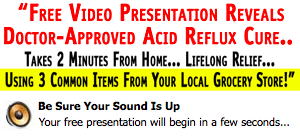October 4, 2011
Esophageal Reflux Disease
Over 60 million Americans suffer from esophageal reflux disease according to the American College of Gastroenterology. Sufferers of esophageal reflux disease, also referred to as acid reflux, describe the feeling as an extreme tightness, a burning sensation, or an explosion in the chest. Esophageal reflux disease is a result of a backup of acids from the stomach and the first part of the small intestine (duodenum) into the esophagus, a 25 centimeter long passageway between the throat and the stomach. Because the esophagus is not equipped with the acid-resistant lining of the stomach, massive heartburn is felt upon acid reflux or backflow. The symptoms, causes, and treatment of esophageal reflux disease are detailed.
Symptoms
The physiological symptoms of esophageal reflux disease are described as follows:
- Heartburn that exceeds two days
- Stomachache
- Difficult or painful swallowing
- Persistent coughing, wheezing, or choking
- Hoarseness
- Regurgitation of food or bitter liquid when lying down or bending
Causes/Factor
The main cause of esophageal reflux disease is a weakening of the lower esophageal sphincter (LES), a valve between the esophagus and stomach that opens as food and liquid travel into the stomach. One factor that causes the LES to weaken is the excessive consumption of caffeinated beverages. Other factors linked to esophageal reflux disease include the following:
- Pregnancy, wherein a woman’s body experiences hormonal changes and abdominal pressure
- Obesity
- Lying down after meals
- Alcoholism
- Smoking
For more information on esophageal reflux disease and cures be sure to check out Reflux Remedy at refluxremedy.com today!
Filed under Acid Reflux Symptoms by admin
January 7, 2011
What to Eat When You Have an Ulcer
If you have an ulcer, eating can often be a bit of a challenge. Ulcers can cause meal time to be painful if it’s a gastric ulcer, or can result in pain hours after eating if it’s an ulcer located in the duodenum. If you have one, you may be wondering what to eat when you have an ulcer. Here are a few tips and tricks that may make meal time a little less painful while your ulcer heals.
1. No matter what you eat, make sure you do so in small portions. Large meals will overwhelm your already sensitive stomach, and can even result in an overproduction of acid, which will exacerbate an existing ulcer. So, rather than eating a few large meals every day go for smaller more frequent ones. That helps your body’s digestive system and makes the healing process go more smoothly.
2. Focus on easily digestible foods, like whole grain seedless breads, certain low acid fruits and vegetables, low fat dairy products (the fats found in milk and cheese can be hard to digest, causing excess acid in your stomach, so aim for low fat products), lean meats, fish and creamed nuts (like low fat peanut or almond butter).
3. Above all, focus on maintaining a balanced diet. Providing your body with the proper nutrition will help it heal much faster.
4. Avoid the following foods if you have an ulcer: Vegetables like onions and tomatoes, anything high in acid; breads that are high in fat like croissants; high acid fruits, like grapefruit, oranges, lemons, and citrus juices; whole milk products and creams; highly seasoned meats, poultry and fish; deli meats; sardines; fried foods; nuts; gravy; and high fat desserts, like cakes, cookies, pastries and donuts.
5. The important thing to remember when you’re trying to let your ulcer heal is to avoid foods that upset your stomach regularly, or can cause heartburn. Things like spicy foods, alcohol, caffeine and garlic can all irritate the stomach and result in additional stomach acid your ulcer doesn?t need.
Here are a few things to add to your new dietary habits that may help your ulcer improve:
1. Reduce your stress level. If you know a meal is going to be painful, try to relax about it. Stressing over it will only make the pain worse. Stress signals your body to produce more stomach acid, which will irritate your ulcer. So, if you feel stress coming on in any situation whether it’s the morning commute, something at work, or your kids at home stop and take a deep breath. Avoiding stress now can have a pretty major impact on pain later.
2. Stop smoking and focus on a healthy lifestyle. Smoking is known to increase stomach acid production. Smoking also slows the body’s ability to heal. Eating healthy and exercising regularly will help your body heal faster.
Practicing all these techniques should help your ulcer heal normally so you can move on with your life.
Still want to know more? Well, stop wondering what to eat when you have an ulcer and head over to refluxremedy.com for more tips and tricks.
September 21, 2010
Gastric Ulcer Causing Diarrhea
While the instances of a gastric ulcer causing diarrhea are few and far between, they do occur in a few individuals, most notably those suffering from Zollinger-Ellison syndrome or ZES. ZES is in fact one of the least common causes of ulcers, although one of the key symptoms is diarrhea. If diarrhea symptoms do appear, there may be a tumor in the pancreas and the duodenum. These tumors are known as gastrinomas, and they cause the production of excessive gastric levels. It is important to note that such tumors are often cancerous, so patients who notice that their gastric ulcer is causing diarrhea should seek diagnosis and treatment immediately. As part of the treatment, your doctor may prescribe anti acid medications in order to prevent the ulcers from recurring.
It is estimated that only 1 person in a million gets ZES each year. The figure is even lower in the category of ulcer sufferers, with only 0.1% to 1% ulcer patients being diagnosed with the condition. ZES generally occurs in people 45 to 50 years old, with men being more prone to the condition than women.
The diagnosis and treatment of ZES begins with the examination of patients suffering from gastric ulcer causing diarrhea. Once H. pylori and a history of NSAID use (both common causes of gastric ulcer related diarrhea) have been ruled out, the doctor will then look into the possibility that it is indeed ZES that the patient is suffering from. In almost all cases, the diarrhea occurs long before the characteristic ulcer symptoms appear. The ulcers related to the condition typically occur in the second, third, or fourth section of the duodenum or the jejunum.
Patients suffering from ZES are also a lot more likely to develop Gastro-esophageal reflux disease or GERD, and the effects of this condition may be more severe than in patients that do not have ZES. GERD itself may cause a number of complications aside from ulcers, including a narrowing of the esophagus.
Since the ulcers that result from the condition can be stubborn and hard to treat, treatment options for ZES tend to be quite involved. In most cases, the patient will have to undergo surgery so the tumors can be successfully removed. At the same time, the patient may also be injected with an intravenous proton pump inhibitor that will help reduce the production of gastric acids. This is a far better treatment option than what was available in the past, when the removal of the stomach was the only alternative.
Another option you may want to consider is the one presented by Refluxremedy.Com. The site offers a safe and effective alternative treatment to gastric ulcer causing diarrhea that will ease your symptoms quickly. And since the method relies on all natural means, you will be able to avoid the side effects and medication interactions that may occur even with over-the-counter medications. For this reason alone, Refluxremedy.Com is worth considering over traditional ulcer treatment methods.





